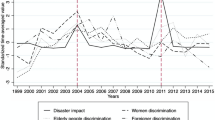Abstract
People adjust to the risks presented by natural disasters in a number of ways; they can move out of harms way, they can self protect, or they can insure. This paper uses Hurricane Andrew, the largest U.S. natural disaster prior to Katrina, to evaluate how people and housing markets respond to a large disaster. Our analysis combines a unique ex post database on the storm’s damage along with information from the 1990 and 2000 Censuses in Dade County, Florida where the storm hit. The results suggest that the economic capacity of households to adjust explains most of the differences in demographic groups’ patterns of adjustment to the hurricane damage. Low income households respond primarily by moving into low-rent housing in areas that experienced heavy damage. Middle income households move away to avoid risk, and the wealthy, for whom insurance and self-protection are most affordable, appear to remain. This pattern of adjustment with respect to income is roughly mean neutral, so an analysis based on measures of central tendency such as median income would miss these important adjustments.
Similar content being viewed by others
References
Banzhaf, H. Spencer and Randall P. Walsh. (2004). “Testing for Environmental Gentrification: Migratory Responses to Changes in Environmental Quality,” Paper presented to the 2004 AERE Workshop, Estes Park, CO (May).
Breen, Vicki and Francis Gupta. (1997). “Coming to the Nuisance or Going to the Barrios? A Longitudinal Analysis of Environmental Justice Claims,” Ecology Law Quarterly 24, 3–56.
Brock, William and Steven Durlauf. (2001). “Discrete Choice with Social Interactions,” Review of Economic Studies 68(April), 235–260.
Carbone, Jared C., Daniel G. Hallstrom and V. Kerry Smith. (2006). “Can Natural Experiments Measure Behavioral Reponses to Environmental Risk?” Environmental and Resource Economics 33(2), 273–297.
Chay, Kenneth and Michael Greenstone. (2005). “Does Air Quality Matter? Evidence from the Housing Market,” Journal of Political Economy 113(2), 376–424.
Chivers, James and Nicholas E. Flores. (2002). “Market Failure in Information: The National Flood Insurance Program,” Land Economics 78(4), 515–521.
Cohen, Charles and Eric Werker. (2005). “The Political Economy of ‘Natural’ Disaster,” Working Paper, Department of Economics, Harvard University (November).
Coulson, N. Edward and Eric W. Bond. (1990). “A Hedonic Approach to Residential Succession,” Review of Economics and Statistics 72(August), 483–444.
Davis, Donald R. and David E. Weinstein. (2002). “Bones, Bombs, and Break Points: The Geography of Economic Activity,” American Economic Review 92(5), 1269–1289.
Greenstone, Michael and Justin Gallagher. (2005). “Does Hazardous Waste Matter? Evidence from the Housing Market and the Superfund Program,” NBER Working Paper 11790 (November).
Hartwig, Robert P. (2002). “Florida Case Study: Economic Impacts of Business Closures in Hurricane Prone Counties,” Working Paper, Insurance Information Institute (June).
Huber, Peter J. (1967). “The Behavior of Maximum Likelihood Estimates Under Non-Standard Conditions,” In: Proceedings of the Fifth Symposium on Mathematical Statistics and Probability. Berkeley, CA: University of California Press.
Kahn, Matthew E. (2005). “The Death Toll from Natural Disasters: The Role of Income, Geography and Institutions,” Review of Economics and Statistics 87(May), 271–284.
Kerr, Oliver. (1993). “Population Estimates and Projections Post-Hurricane Andrew: Dade County, Florida, 1993,” Unpublished report, Metropolitan Dade County Planning Department (May).
Krugman, Paul. (1998). “Space: The Final Frontier,” Journal of Economic Perspectives 12(Spring), 161–174.
Longman, Phillip. (1994). “The Politics of Wind,” Florida Trend 37(5), 30–39.
Miguel, Edward and Gerard Roland. (2006). “The Long Run Impact of Bombing Vietnam,” NBER Working Paper 11954 (January).
Tiebout, Charles M. (1956). “A Pure Theory of Local Expenditures,” Journal of Political Economy 64(October), 416–424.
Wakimoto, Roger M. and Peter G. Black. (1994). “Damage Survey of Hurricane Andrew and its Relationship to the Eyewall,” Bulletin of the American Meteorological Society 75(February), 189–200.
Author information
Authors and Affiliations
Corresponding author
Additional information
W.P. Carey Professor of Economics, Arizona State University, and Resources for the Future, University Fellow; Assistant Professor, Williams College; Assistant Professor Virginia Tech; Affiliated Economist, CEnREP, North Carolina Sate University; Graduate Student, University of North Carolina at Chapel Hill, respectively. Smith’s research was partially supported by the United States Department of Homeland Security through the Center for Risk and Economic Analysis of Terrorism Events (CREATE), grant number EMW-2004-GR-0112. However, any opinion, findings, and conclusions or recommendations in this document are those of the author(s) and do not necessarily reflect views of the U.S. Department of Homeland Security. Thanks are due to H. Spencer Banzhaf, Kathleen Bell, David Card, Matt Kahn, Richard Ready, Kip Viscusi, and participants in Harvard’s Kennedy School and Texas A&M University’s Environmental Economics Workshops for very helpful comments on earlier summaries of this research. Thanks are also due Alex Boutaud, Susan Hinton, and Kenny Pickle for assistance in preparing the manuscript.
JEL Classification Q51 · Q54
Rights and permissions
About this article
Cite this article
Smith, V.K., Carbone, J.C., Pope, J.C. et al. Adjusting to natural disasters. J Risk Uncertainty 33, 37–54 (2006). https://doi.org/10.1007/s11166-006-0170-0
Issue Date:
DOI: https://doi.org/10.1007/s11166-006-0170-0




